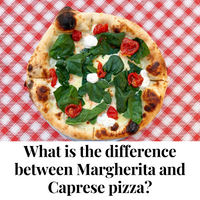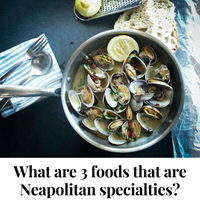
The debate between cornmeal and semolina as the ideal pizza dough base has been discussed for years.
Some swear by the light and airy texture of the cornmeal-based dough, while others find the semolina-based dough to be more sturdy and easier to work with. Ultimately, it is up to the individual baker to decide which type of dough they prefer.
However, according to us, you should pick semolina over cornmeal for authentic Italian pizza. Let’s begin knowing more without any further ado.
Cornmeal vs. Semolina: What Are The Differences?
You may wonder what the difference between cornmeal flour and semolina flour is. Both flours come from durum wheat and are coarser in texture than regular wheat flour. Their color may vary, though, from dark brown to golden.
You can substitute one type for the other in almost any recipe and still get good results. Here's a quick comparison of the two types.
Nutrition Factors
A few of the similarities between semolina and cornmeal flour are apparent. Both flours contain high amounts of gluten, protein, and dietary fiber.
Health Factors
However, there are a few health risks associated with semolina. This may be a problem for those with wheat allergies, but it's best to try it out slowly and see how it affects your body.
Also, because it is so high in glutamate, it's essential to be aware of changes in your body's metabolism. If you're gluten-intolerant, you should avoid it.
Versatility
Semolina is often used to make pizza and pasta. It is very versatile and can be combined with other flour types. Its high protein content makes it a good choice for pasta-making. Semolina helps pasta maintain its shape while cooking.
Cornmeal flour is the more common of the two. It is used to make pasta and has the highest gluten content of any durum wheat flour. It has a delicate taste and is usually pale yellow.
However, it can also be used as a coating for baking sheets, breakfast cereal, and dumplings, among other dishes.
It also imparts a distinct coarse texture to baked goods and is an excellent substitute for flour in some recipes. If you're unsure which flour to use, try combining both types for an exciting flavor and texture.
Texture and Taste
When comparing cornmeal flour with semolina flour, consider the differences in texture and taste. Both types are finer and have a slightly sweeter taste.
The taste of cornmeal is similar to that of cornstarch, starch from corn. This ingredient adds flavor and texture to recipes but differs from cornmeal in its refining process.
Alternatives
Those with gluten allergies may want to substitute gluten-free flour like amaranth or garbanzo flour. You can also use rice flour instead of cornmeal, though your finished dish may be softer than the original.
Another gluten-free option is Kamut, a grain used for centuries in ancient Egypt. Kamut flour is rich in vitamins, minerals, and gluten. It is a good substitute for semolina flour in baking and pasta recipes and even in making gluten-free items.
And don't forget that quinoa, a type of seed related to amaranth, is gluten-free and contains the highest protein content of all grains.
Cornmeal vs. Semolina: Which One Goes Best with Pizza?
If you are a fan of Italian food, you've probably wondered what the best flour for making pizza is. While both semolina and cornmeal can do the same job, some people prefer one over the other.
Semolina Is Better For Pizza: Here’s Why
Regardless of your personal preference, semolina flour has the advantage of being coarser and less prone to hydrating than cornmeal. That's because it has a larger particle size, which creates a ball-bearing effect under the dough skin.
This means the dough is less likely to stretch when baking, which prevents burnt flour on the bottom of the crust. However, you can also substitute semolina for cornflour.
Both cornmeal and semolina help make the dough slide off the pizza peel without sticking. The reason why you should use them is that they are both excellent release materials.
Cornmeal allows the pizza to slide off the peel without difficulty, while semolina imparts grit to the bottom of the pizza. But remember, you should never use more than one of these flours on your pizza.
Another critical factor is texture and taste. While cornmeal is coarser than wheat flour, it can burn when exposed to heat. However, it's easy to make and tastes great too! If you’re wondering about the best way to cut your pizza, click here to find more!
Why You Should Use Cornmeal Flour For Baking Pizza
Read this article if you are wondering why you should use cornmeal flour for your pizza crusts. Aside from its taste and texture, cornmeal is free of gluten.
You can still bake your pizza with cornmeal flour if you don't have baking steel. It is an excellent alternative to regular flour, and you can find recipes for both options on this website.
Experiment With Flavors
Both cornmeal and semolina add flavor and texture to your pizza, which is an important feature when baking your pizza. You can also sprinkle it over the dough for a crisp, golden-brown crust.
It is also easy to use and will give your pizza a nutty flavor. Cornmeal is an excellent option for pizza crusts, as it is just as easy to make as regular dough.
Cornmeal provides a good taste and texture and keeps the pizza from sticking to the pan. It is gluten-free and has more nutrients than regular flour, so adding cornmeal to your pizza dough won't significantly alter the nutritional value of the final product.
Just keep in mind that cornmeal is not the same as semolina, and you shouldn't confuse it with it. Both cornmeal and semolina have similar appearances and uses.
Why You Should Use Semolina Flour for Baking Pizza

If you want to make your pizza crust a little more crunchy, try using semolina flour. Semolina is excellent for making crusts that won't stick to your baking trays.
If you don't want to use semolina flour, you can substitute it with Caputo 00 flour. You can even make the base ahead of time and store it in the fridge or freezer to bake later.
How To Make Pizza With Semolina Flour
- To make the dough, combine the semolina with the all-purpose flour and salt.
- Mix the yeast into the water and add it slowly, mixing well.
- Let the dough rise from one to one and a half hours, depending on the kitchen's temperature.
- When the dough is ready, divide it into three equal pieces and shape each into a ball.
- Once the dough has doubled in size, turn it over and continue mixing with your hands.
- After the dough takes shape, add an extra teaspoon or two of water if needed.
One of the main differences between semolina and all-purpose flour is the texture. While all-purpose flour has a higher protein content than semolina, it is not as high as semolina.
If you want a crisp crust on your pizza, use semolina flour. You can also use Caputo or Pizza flour.
The problem with cornmeal or bread crumbs is that they leave a gritty residue on the bottom of the pizza. Moreover, semolina flour is more delicate and will rip and tear if you over-mix it.
The Best Semolina for Pizza Peel
The best semolina for a pizza peel is coarsely ground wheat, which does not easily char, and does not impart a raw flour taste to your crust.
A small amount will do for two pies without brushing the peel with flour. Alternatively, you can use all-purpose flour to make a large pizza. A thin layer of semolina flour will work as well.
The best semolina for a pizza peel is the type that covers all of the resting areas of the dough evenly. You don't want to leave any gaps.
Even distribution is critical. Don't over-spread the semolina, as it can cause the dough to stick to the peel. To ensure the dough is not attached, jiggle the peel a bit to check that it is not sticking.
A few tips for the best semolina for a pizza peel can help ease the transition to a wood peel. The wood peel needs to be dry before cooking. You can also use plain flour if you don't want to use semolina.
Remember that the oven must be hot enough to prevent the dough from sticking. An excellent way to avoid sticking your dough on the peel is to use flour that contains some cornmeal.
Cornmeal is an excellent release material when you dress your dough and slide it effortlessly off the peel. Another benefit of cornmeal is that it adds a subtle grit to the bottom of the pie.
Conclusion
If you want to make a thin-crust pizza, you can use semolina instead of cornmeal. This flour doesn't absorb moisture either, and it's a good compromise between cornmeal and regular flour.
But some chefs swear by other, more exotic ingredients such as wheat bran or rice flour. Whether or not these ingredients are effective is up to you, but they are not as common as semolina. Whichever pizza you enjoy, authentic Margherita pizza will never disappoint you, so order now!
Our real Italian pizzas from Italy are handmade with all-natural high quality and fresh ingredients in Naples, Italy delivered to you, anywhere in the U.S. Click Here to Buy Now!









0 comments